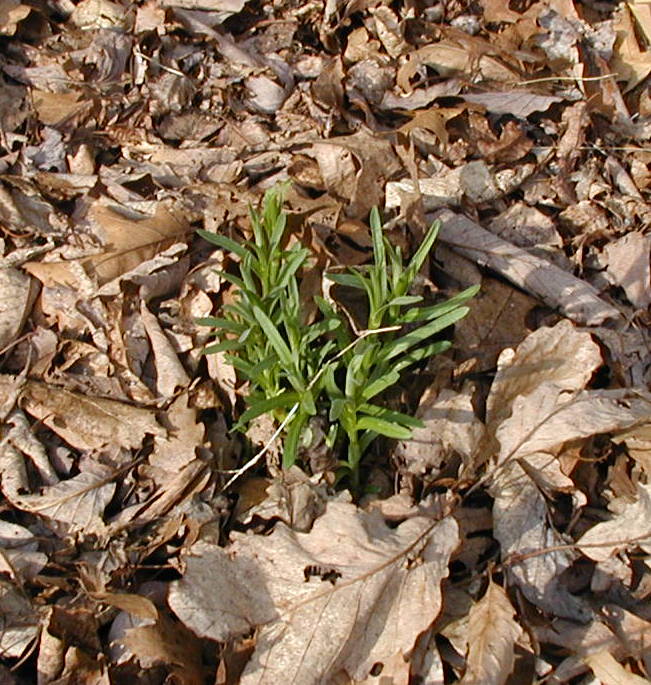Herb: Tarragon
Tarragon, Artemisia dracunculus, is a culinary herb used to flavor meats and vegetables.
In warmer locations tarragon grows to 3 feet tall. In colder climates tarragon attains 12 inches, or one year’s growth as it grows annually unless pots are brought inside. Tarragon leaves are long, narrow and somewhat twisted.
Tarragon Characteristics
- annual in cool climates, perennial in warm locations
- evergreen leaves are twisted
- pointed, linear leaves
- aromatic leaves are dark green
Tarragon Uses
- culinary
- gardening
Growing Tarragon
Growing conditions: Tarragon grows perennially in Mediterranean-like conditions. In Northeastern US, tarragon plants must be protected from freezing temperatures.
Light: sun, partial shade
Height: 36 inches
Spacing: 12 inches
Planting comments: Needs well-drained soil.
Tarragon Images

Where to Buy Tarragon
Tarragon is available as transplants. Depending on the time of year you may be able to find a plant at your nearby garden center. In case they’re are not available locally, here are some places that offer herb seeds and herb plants.
- Abundant Life Seeds Cottage Grove, OR
- Artistic Gardens / Le Jardin du Gourmet St. Johnsbury Center, VT
- Baker Creek Heirloom Seeds Mansfield, MO
- Bluestone Perennials, Inc. Madison, OH
- BorgheseGardens.com Gautier, MS
- Bountiful Gardens Palo Alto, CA
- Companion Plants Athens, OH
- Ed Hume Seeds Puyallup, WA
- Eden Organic Nursery Services, Inc. Davie, FL
- Garden Medicinals and Culinaries Mineral, VA
- GreenDealer Exotic Seeds Louisville, KY
- Heirloom Seeds West Elizabeth, PA
- Henry Field Seed and Nursery Co. Aurora, IN
- High Altitude Gardens Cornville, AZ
- Irish Eyes Garden Seeds Ellensburg, WA
- Jim Johnson, Seedman Gautier, MS
- John Scheepers Kitchen Garden Seeds, LLC. Bantam, CT
- Johnny’s Selected Seeds Winslow, ME
- Jung Quality Seeds Randolph, WI
- Logee’s Greenhouses, Ltd. Danielson, CT
- NESEED.com Hartford, CT
- Nichols Garden Nursery Albany, OR
- Ornamental Edibles San Jose, CA
- Otto Richter and Sons Limited. Goodwood, ON, Canada
- Peaceful Valley Farm Supply, Inc. Grass Valley, CA
- Pepper Gal Fort Lauderdale, FL
- Peters Seed and Research may be out of business,
- Pinetree Garden Seeds New Gloucester, ME
- R.H. Shumway’s Randolph, WI
- Redwood City Seed Co. Redwood City, CA
- Renee’s Garden Seeds Felton, CA
- Seed Savers Exchange Decorah, IA
- Southern Exposure Seed Exchange Mineral, VA
- Stokes Seeds Inc. Buffalo, NY
- The Cook’s Garden Warminster, PA
- The Gourmet Gardener Live Oak, FL
- Thompson and Morgan Jackson, NJ
- Underwood Gardens Chino Valley, AZ
- Veseys Seeds Ltd. Calais, ME
- Victory Seed Company Molalla, OR
- W. Atlee Burpee & Co. Warminster, PA
- Willhite Seed, Inc. Poolville, TX
In case you can’t find what you’re looking for commercially, take a look at some of the online seed swap sites where you can find many unusual plants and common ones, too.
Chef’s Article: Tarragon the Anise-Scented Herb for Chicken and Fish
by Naomi Gallagher
Tarragon is a perennial herb and a member of the aster family, Asteraceae. Native to western Asia and Siberia, tarragon is now cultivated in southern Europe and in North America. Two closely related plants are known as tarragon. Artemisia dracunculus is known as French tarragon and its close cousin, A. dracunculoides, is called Russian tarragon or false tarragon. Russian tarragon has coarser leaves and a less delicate flavor, so it’s not considered the true tarragon. The term tarragon may be used for either plant and the herb consisting of their leaves.
The tarragons are hardy herbal plants that rarely set seeds, so propagation is usually via stem cuttings or root division. In order to keep growing the roots must experience a winter period. The root or crown should be taken up, divided and re-planted every three to four years. Leaves can be harvested throughout the growing season and the leafy tops cut back to provide fresh herb for the kitchen.
The twisted leaves of tarragon are narrow, measuring about two inches long. They are used to add flavor and scent to savory foods. The delicate, anise-scented flavor of tarragon enhances mild flavored dishes like chicken and fish. Tarragon is added to herb vinegars, dressings, sauces, fish and seafood, tartar sauce, egg dishes, pasta, poultry, pickles, tomatoes and salads. Chicken salad, potato salad, mayonnaise-based spreads for sandwiches, or sour cream dips for vegetables are delicious ways to appreciate the fresh taste of tarragon. Tarragon is an ingredient in the French herb mixture fines herbes.
Some flavor is lost on drying, so this herb is best used fresh. However, dried chopped tarragon can be found on grocery spice shelves. Freezing tarragon is a better option than drying it as the aroma and flavor will be stronger. Place a few sprigs of tarragon in a plastic zip bag in the freezer. Use scissors to snip off the amount of tarragon needed for a recipe and replace the frozen tarragon back in the freezer. Harvest the tops of tarragon branches from the herbal garden before flowering begins for the best aroma.
Tarragon is cultivated as a flavoring agent. The herb itself is used in cooking to add its anise-like flavor to savory dishes. On a commercial scale tarragon is distilled to obtain the essential oil, 0.3 to 1%. The main ingredient in the essential oil is methyl chavicol or estragole. Sometimes called estragon oil, oil of tarragon is used commercially as a flavoring and scenting agent. Components of the essential oil of tarragon may lend it digestive, diuretic and laxative properties.